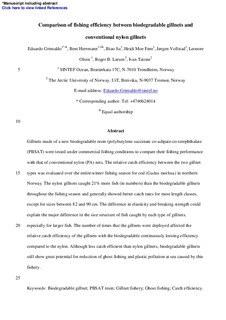Comparison of fishing efficiency between biodegradable PBSAT gillnets and conventional nylon (PA) gillnets
Grimaldo, Eduardo; Herrmann, Bent; Su, Biao; Føre, Heidi Moe; Vollstad, Jørgen; Olsen, Leonore; Larsen, Roger B.; Tatone, Ivan
Journal article, Peer reviewed
Accepted version
Permanent lenke
http://hdl.handle.net/11250/2594521Utgivelsesdato
2018Metadata
Vis full innførselSamlinger
Originalversjon
Fisheries Research, 2019, 213, 67-74Sammendrag
Gillnets made of a new biodegradable resin (polybutylene succinate co-adipate-co-terephthalate (PBSAT) were tested under commercial fishing conditions to compare their fishing performance with that of conventional nylon (PA) nets. The relative catch efficiency between the two gillnet 15 types was evaluated over the entire winter fishing season for cod (Gadus morhua) in northern Norway. The nylon gillnets caught 21% more fish (in numbers) than the biodegradable gillnets throughout the fishing season and generally showed better catch rates for most length classes, except for sizes between 82 and 90 cm. The difference in elasticity and breaking strength could explain the major difference in the size structure of fish caught by each type of gillnets, especially for larger fish. The number of times that the gillnets were deployed affected the relative catch efficiency of the gillnets with the biodegradable continuously loosing efficiency compared to the nylon. Although less catch efficient than nylon gillnets, biodegradable gillnets still show great potential for reduction of ghost fishing and plastic pollution at sea caused by this fishery.
